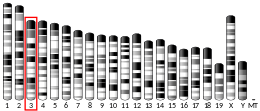CRTC2
CREB regulated transcription coactivator 2, also known as CRTC2, is a protein which in humans is encoded by the CRTC2 gene.[5][6][7]
Function
CRTC2, initially called TORC2, is a transcriptional coactivator for the transcription factor CREB and a central regulator of gluconeogenic gene expression in response to cAMP.[8] CRTC2 is thought to drive tumorigenesis in LKB11/STK11-null non-small cell lung cancers (NSCLC).[9]
References
- GRCh38: Ensembl release 89: ENSG00000160741 - Ensembl, May 2017
- GRCm38: Ensembl release 89: ENSMUSG00000027936 - Ensembl, May 2017
- "Human PubMed Reference:". National Center for Biotechnology Information, U.S. National Library of Medicine.
- "Mouse PubMed Reference:". National Center for Biotechnology Information, U.S. National Library of Medicine.
- "Entrez Gene: CRTC2 CREB regulated transcription coactivator 2".
- Iourgenko V, Zhang W, Mickanin C, Daly I, Jiang C, Hexham JM, et al. (October 2003). "Identification of a family of cAMP response element-binding protein coactivators by genome-scale functional analysis in mammalian cells". Proceedings of the National Academy of Sciences of the United States of America. 100 (21): 12147–52. doi:10.1073/pnas.1932773100. PMC 218727. PMID 14506290.
- Conkright MD, Canettieri G, Screaton R, Guzman E, Miraglia L, Hogenesch JB, Montminy M (August 2003). "TORCs: transducers of regulated CREB activity". Molecular Cell. 12 (2): 413–23. doi:10.1016/j.molcel.2003.08.013. PMID 14536081.
- Cheng A, Saltiel AR (March 2006). "More TORC for the gluconeogenic engine". BioEssays. 28 (3): 231–4. CiteSeerX 10.1.1.604.5745. doi:10.1002/bies.20375. PMID 16479585.
- Rodón L, Svensson RU, Wiater E, Chun MG, Tsai WW, Eichner LJ, et al. (July 2019). "The CREB coactivator CRTC2 promotes oncogenesis in LKB1-mutant non-small cell lung cancer". Science Advances. 5 (7): eaaw6455. doi:10.1126/sciadv.aaw6455. PMC 6656544. PMID 31355336.
- Screaton RA, Conkright MD, Katoh Y, Best JL, Canettieri G, Jeffries S, et al. (October 2004). "The CREB coactivator TORC2 functions as a calcium- and cAMP-sensitive coincidence detector". Cell. 119 (1): 61–74. doi:10.1016/j.cell.2004.09.015. PMID 15454081.
- Ewing RM, Chu P, Elisma F, Li H, Taylor P, Climie S, et al. (2007). "Large-scale mapping of human protein-protein interactions by mass spectrometry". Molecular Systems Biology. 3 (1): 89. doi:10.1038/msb4100134. PMC 1847948. PMID 17353931.
Further reading
- Maruyama K, Sugano S (January 1994). "Oligo-capping: a simple method to replace the cap structure of eukaryotic mRNAs with oligoribonucleotides". Gene. 138 (1–2): 171–4. doi:10.1016/0378-1119(94)90802-8. PMID 8125298.
- Suzuki Y, Yoshitomo-Nakagawa K, Maruyama K, Suyama A, Sugano S (October 1997). "Construction and characterization of a full length-enriched and a 5'-end-enriched cDNA library". Gene. 200 (1–2): 149–56. doi:10.1016/S0378-1119(97)00411-3. PMID 9373149.
- Iourgenko V, Zhang W, Mickanin C, Daly I, Jiang C, Hexham JM, et al. (October 2003). "Identification of a family of cAMP response element-binding protein coactivators by genome-scale functional analysis in mammalian cells". Proceedings of the National Academy of Sciences of the United States of America. 100 (21): 12147–52. doi:10.1073/pnas.1932773100. PMC 218727. PMID 14506290.
- Conkright MD, Canettieri G, Screaton R, Guzman E, Miraglia L, Hogenesch JB, Montminy M (August 2003). "TORCs: transducers of regulated CREB activity". Molecular Cell. 12 (2): 413–23. doi:10.1016/j.molcel.2003.08.013. PMID 14536081.
- Jin J, Smith FD, Stark C, Wells CD, Fawcett JP, Kulkarni S, et al. (August 2004). "Proteomic, functional, and domain-based analysis of in vivo 14-3-3 binding proteins involved in cytoskeletal regulation and cellular organization". Current Biology. 14 (16): 1436–50. doi:10.1016/j.cub.2004.07.051. PMID 15324660.
- Screaton RA, Conkright MD, Katoh Y, Best JL, Canettieri G, Jeffries S, et al. (October 2004). "The CREB coactivator TORC2 functions as a calcium- and cAMP-sensitive coincidence detector". Cell. 119 (1): 61–74. doi:10.1016/j.cell.2004.09.015. PMID 15454081.
- Al-Hakim AK, Göransson O, Deak M, Toth R, Campbell DG, Morrice NA, et al. (December 2005). "14-3-3 cooperates with LKB1 to regulate the activity and localization of QSK and SIK". Journal of Cell Science. 118 (Pt 23): 5661–73. doi:10.1242/jcs.02670. PMID 16306228.
- Siu YT, Chin KT, Siu KL, Yee Wai Choy E, Jeang KT, Jin DY (July 2006). "TORC1 and TORC2 coactivators are required for tax activation of the human T-cell leukemia virus type 1 long terminal repeats". Journal of Virology. 80 (14): 7052–9. doi:10.1128/JVI.00103-06. PMC 1489057. PMID 16809310.
- Wu Z, Huang X, Feng Y, Handschin C, Feng Y, Gullicksen PS, et al. (September 2006). "Transducer of regulated CREB-binding proteins (TORCs) induce PGC-1alpha transcription and mitochondrial biogenesis in muscle cells". Proceedings of the National Academy of Sciences of the United States of America. 103 (39): 14379–84. doi:10.1073/pnas.0606714103. PMC 1569674. PMID 16980408.
- Yang Q, Inoki K, Ikenoue T, Guan KL (October 2006). "Identification of Sin1 as an essential TORC2 component required for complex formation and kinase activity". Genes & Development. 20 (20): 2820–32. doi:10.1101/gad.1461206. PMC 1619946. PMID 17043309.
- Ewing RM, Chu P, Elisma F, Li H, Taylor P, Climie S, et al. (2007). "Large-scale mapping of human protein-protein interactions by mass spectrometry". Molecular Systems Biology. 3 (1): 89. doi:10.1038/msb4100134. PMC 1847948. PMID 17353931.
- Ravnskjaer K, Kester H, Liu Y, Zhang X, Lee D, Yates JR, Montminy M (June 2007). "Cooperative interactions between CBP and TORC2 confer selectivity to CREB target gene expression". The EMBO Journal. 26 (12): 2880–9. doi:10.1038/sj.emboj.7601715. PMC 1894761. PMID 17476304.
- Kuraishy AI, French SW, Sherman M, Herling M, Jones D, Wall R, Teitell MA (June 2007). "TORC2 regulates germinal center repression of the TCL1 oncoprotein to promote B cell development and inhibit transformation". Proceedings of the National Academy of Sciences of the United States of America. 104 (24): 10175–80. doi:10.1073/pnas.0704170104. PMC 1891214. PMID 17548807.
External links
- CRTC2+protein,+human at the US National Library of Medicine Medical Subject Headings (MeSH)
- Human CRTC2 genome location and CRTC2 gene details page in the UCSC Genome Browser.
- Overview of all the structural information available in the PDB for UniProt: Q53ET0 (Human CREB-regulated transcription coactivator 2) at the PDBe-KB.
- Overview of all the structural information available in the PDB for UniProt: Q3U182 (Mouse CREB-regulated transcription coactivator 2) at the PDBe-KB.
This article is issued from Wikipedia. The text is licensed under Creative Commons - Attribution - Sharealike. Additional terms may apply for the media files.



